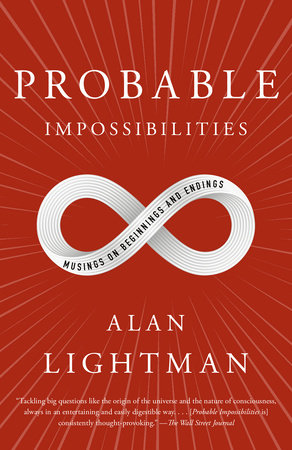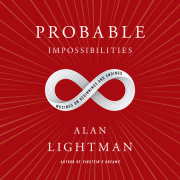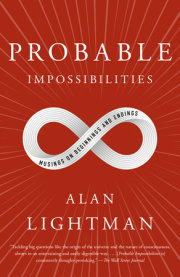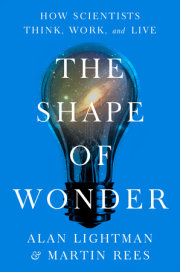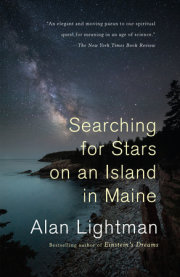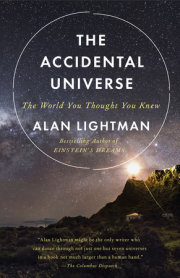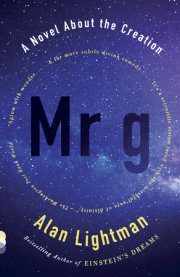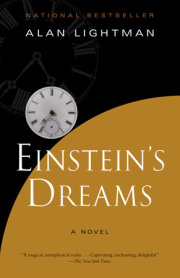Probable ImpossibilitiesI will tell you a thing that is both impossible and true. You were born from a tiny seed within your mother. And she was born from a tiny seed within her mother. And she from her mother. And so on, back and back through the dim hallways of time until we arrive at a particular cave in Africa, a hundred thousand years in the past, with a particular woman sitting by a fire. That woman knew nothing of cities or automobiles or electricity. But if we could follow her daughters through time, we would eventually arrive at you. If each of those daughters of daughters had pressed an inky thumb on a large piece of parchment, one following the other, there would today be several thousand thumbprints on that parchment, leading from that ancestral woman a hundred thousand years ago to your thumbprint today.
If this story does not seem impossible, or at least incomprehensible, let’s go further back in time. According to modern analysis of the DNA of fossil animals, your ancestral mother descended from more primitive creatures, and those from more primitive, until we reach single-celled organisms squirming and gyrating in a primeval sea. And those first living organisms emerged from the billions of random collisions of lifeless molecules, by chance forming things that could spawn more of themselves and tap energy from the roiling sea. And before that, the ancient air of Earth—methane and ammonia and water vapor and nitrogen—blew over the seething volcanoes. And before, the gases swirled and condensed from a cloud in the primeval solar system.
I will tell one final story. Every atom in your body except for hydrogen and helium was made in stars long ago and blown into space when those stars exploded—much later to be tossed into the air and soil and oceans of Earth and eventually incorporated into your body. How do we know? Evidence supports the Big Bang theory, which holds that our universe began in a state of extremely high density and temperature and has been expanding and cooling since. In the first moments after t = 0, the universe was far too hot for atoms to hold together. During the first three minutes, the universe cooled enough for the simplest atomic nuclei, hydrogen and helium, to form, but was thinning out too rapidly to make carbon and oxygen and nitrogen and all the other atoms our bodies are made of. According to nuclear physicists, the formation of those atoms occurred hundreds of millions of years later, when gravity was able to pull together large masses of gas to form stars. The temperatures and densities at the centers of those masses again began to mount, starting nuclear reactions, which fused the existing hydrogen and helium atoms into the other atoms in our bodies. Some of those stars exploded, seeding space with the newly forged atoms. With our telescopes, we have seen exploding stars and analyzed the chemical composition of their debris. We have confirmed the theory. If you could tag all the atoms in your body and follow them backward in time, every atom, except for hydrogen and helium, would return to a star. We are as certain of this story as we are that the continents were once joined.
Less certain but supported by compelling calculations are the infinities, the infinity of the small and the infinity of the large. The unending world of ever smaller things within the atom, and the unending world of ever larger things, beyond our telescopes. Between these two endpoints of the imagination are we human beings, fragile and brief, clutching our thin slice of reality.
Between Nothingness and Infinity
In a lifetime, most people travel no farther than five hundred miles from home. During that limited exploration of the physical world, we record memories of nearby objects and experiences—people, houses, trees, local lakes and rivers, sounds of birds, clouds—all funneled into our brains by our eyes and ears. And yet think what we are able to imagine. Take, for example, Homer’s epic tale of the voyage of Ulysses. At one point, Ulysses and his men are captured by the Cyclops, a thirty-foot-tall man with a single eye in the middle of his forehead, who immediately eats two of the crew and imprisons the rest in his cave for future meals. On the seas again after his escape, Ulysses ties himself to the ship’s mast so that he can resist the call of the Sirens, creatures with the bodies of birds and the heads of women, whose beautiful song lures men to their doom on the reefs. Or consider Salvador Dalí’s famous painting The Persistence of Memory, in which rubbery clocks droop over tree branches and tables like pizzas melting in the Sun. Horses with wings, rivers of gold, wooden puppets that come to life. In our minds, we have the power to combine things that we’ve seen in our paltry experience to create spectacular apparitions never before encountered, and even things that do not exist.
Imagination in the arts is familiar. Imagination in science not so familiar, yet breathtaking in its daring and frequent validation. Following the logical trail of his equations, James Clerk Maxwell imagined waves of electromagnetic energy traveling through space—X-rays and radio waves invisible to the eye. Einstein imagined that clocks moving past each other would tick at different rates, although such a preposterous phenomenon had never been observed. (To measure the effect, highly sensitive instruments are required, or relative speeds approaching the speed of light.)
The ancient Greeks hypothesized invisible atoms, minuscule things too small to see, indestructible, indivisible, the presumed building blocks of the material world—another leap of the imagination. Two thousand years later, a Frenchman named Blaise Pascal (1623–1662) imagined much further. Mathematician, physicist, inventor, essayist, and theologian, Pascal conjectured the existence of things infinitely small and infinitely large. From his Pensées:
The whole visible world is only an imperceptible atom in the ample bosom of nature . . . We may enlarge our conceptions beyond all imaginable space; we only produce atoms in comparison to the reality of things. It is an infinite sphere, the center of which is everywhere, the circumference nowhere . . . What is man in the infinite? But to show him another prodigy equally astonishing, let him examine the most delicate things that he knows. Let a mite be given him, with its minute body parts and parts incomparably more minute. Dividing these last things again, let him exhaust his powers of conception and let the last object at which he can arrive be now that of our discourse. Perhaps he will think that here is the smallest point of nature. I will let him see therein a new abyss . . . For who will not be astounded at the fact that our body, which a little while ago was imperceptible in the universe . . . is now a colossus, a world, or rather a whole in respect of the nothingness which we cannot reach? He who regards himself in this light will be afraid of himself, and observing himself sustained in the body given him by nature between these two abysses of the Infinite and Nothing will tremble at the sight of these marvels . . . [Man] is equally incapable of seeing the Nothing from which he was made, and the Infinite in which he is swallowed up.
At the time that Pascal wrote this remarkable passage, the first crude microscopes had only recently been invented, and the greatest distance measured was that to the Sun. In particular, the size of the crystalline “heavenly sphere,” on which hung the stars, was completely unknown. Working in a cold and dimly lit house on the outskirts of Paris, at a time when forced bleeding was thought to cure illness and the medicine cabinet brimmed with mercury and arsenic, when fire and electricity were totally mysterious, Pascal imagined infinity.
It was not only the physical infinities that captured Pascal’s imagination. He was also concerned with the manner in which we human beings situate ourselves in the world, trapped in the bodies given us by nature, “caught between the two abysses of the Infinite and Nothing.” One finds no such human considerations and poetry in the writings of Newton several decades later. Pascal was practically unique in being a humanist and a scientist at once—a close observer of human nature in such works as “The Misery of Man Without God” (Pascal was deeply religious), a worldly man born into the upper levels of French society, and a guest of the salons of Paris—while at the same time a mathematician who made seminal contributions to projective geometry, an inventor who designed one of the first mechanical computers, a pioneer in the theory of probability. A unit of pressure, the pascal, is named after him. As is a computer programming language. One might compare Pascal to another great polymath of the Renaissance, Leonardo da Vinci. Yet even da Vinci did not contemplate infinity.
A famous portrait of Pascal, painted by his contemporary Philippe de Champaigne, shows a man of about thirty-five (Pascal died at age thirty-nine), with pink cheeks set against pale, sickly skin, hints of a delicate moustache and beard, a prominent and aristocratic nose, dark hair in curls hanging down to his shoulders, a green blouse like embroidered drapery slung across his chest, a starched white collar, and a vague, almost suffering smile, as if he is contemplating the misery of man without God and struggling to make the best of a sinful world.
Pascal was born into a well-to-do and devout family at Clermont, in Auvergne. His father was a government official and tax collector. The young Blaise early showed precocity in mathematics and all things mechanical. While still a teenager, he started building calculating machines to help his father with his tax computations. After fifty prototypes, young Pascal succeeded in creating a finished machine, now called a “Pascal calculator.” The gadget looks like a copper shoebox. Six windows show numbers, with six spoked metal dials below them. To input a digit, you place a stylus between the spokes of a dial and turn it until the number comes up in the corresponding window. Then you enter another digit in the next dial. By way of gears, the sum of the two numbers appears in another window.
At age sixteen, young Pascal taught himself geometry, helped by his drawing of charcoal figures on the flagstone floor. Soon, he discovered what is now known as “Pascal’s theorem”: If six arbitrary points are chosen on a conic section (the curve formed by the intersection of a plane with a cone) and joined by line segments in any order to form a hexagon, then the three pairs of opposite sides of the hexagon meet at three points (G, H, and K in the figure below), which lie on a straight line. I am not aware of any practical applications of Pascal’s theorem, although it has been advertised as a great theorem to prove for the world’s brightest high school students in the International Mathematical Olympiad.
It is likely that Pascal conjured up his notions of infinity during his work on a new field of mathematics called projective geometry. That subject deals with the properties of shapes that are unchanged when they are projected onto other surfaces, like an object’s shadow on the floor. One of the concepts of projective geometry is “the point at infinity,” which arises in perspective drawing when one imagines, for example, extending a narrowing street indefinitely, until the parallel lines appear to meet. Although “the point at infinity” does not exist in the physical world (and certainly not in Pascal’s knowledge of the physical world), it can be imagined.
After his father died in 1650, Pascal inherited a good deal of money, and he continued to mix with the best of society, as befitting his wealth. For a time, he kept a coach with six horses. Living in fashionable society and attending the various salons of Paris, Pascal was a man of the world. Paradoxically, he also became involved with an ascetic religious sect known as Jansenism, named after Cornelius Jansen, bishop of Ypres. The Jansenists were as strict as the Puritans, obsessed with original sin, human depravity, and predestination. T. S. Eliot once described Pascal as “a man of the world among ascetics, and an ascetic among men of the world; he had the knowledge of worldliness and the passion of asceticism, and in him the two are fused into an individual whole.”
In addition to his scientific work, Pascal is known for his influential but unfinished Pensées (Thoughts), a collection of fragments on theology and philosophy, and often biting quips about other intellectuals of the day. Sickly for much of his life, Pascal died in August 1662, most probably of stomach cancer. In his later years, he commented that “sickness is the natural state of Christians . . . one hour’s pain is a better teacher than all the philosophers put together.”
What interests me most about Blaise Pascal is his imagination of the infinities—the infinitely small and the infinitely large—and the convolution of human beings with those unattainable realms. Certainly, Christian religious thinkers from St. Augustine on had discussed the infinite power of God. But there was no evidence of any physical thing remotely approaching the hugely small or the hugely large. Evidently, Pascal was mentally following the narrowing street, on and on in the world of his imagination. Scientists today have done the same. And with new discoveries in physics and astronomy—discoveries that not even Pascal could have imagined—we have found astonishing limits to the large and the small. Not mundane limits caused by the inadequacy of our measuring devices, but fundamental limits caused by the nature of time and space.
First, the large. A giant being, gazing at the cosmos, would see outer space as a vast dark sea, mostly empty but punctuated by glowing islands of light, the galaxies. On average, each galaxy, like our Milky Way, contains about a hundred billion stars and is about a thousand billion times the size of a star. Astronomers have, in fact, measured distances out to several hundred thousand galaxy diameters, the farthest known regions of reality. Space could extend far beyond even that great distance, but we can never see it for a fascinating reason. Since the 1920s, we have observed with our giant telescopes that the universe is expanding, with the galaxies moving away from one another like points painted on an expanding balloon. If that picture is played backward, the matter of the universe hurtles together until a definite time in the past, about fourteen billion years ago, when everything was crammed together into a region of enormously high density and temperature, the so-called Big Bang beginning of our universe. The universe could be infinite in extent, but we cannot see beyond a certain distance because there hasn’t been enough time since the Big Bang for light to have traveled from there to here. It is as if we found ourselves in a vast dark palace, with unlit chandeliers covering the ceiling, and suddenly the lights are turned on (the Big Bang).
Copyright © 2021 by Alan Lightman. All rights reserved. No part of this excerpt may be reproduced or reprinted without permission in writing from the publisher.

